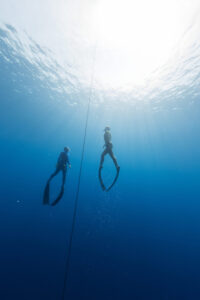DEEP DIVING BEST LEFT TO THE EXPERTS
 Modern scuba gear allows even beginner divers to go many feet below the ocean’s surface safely and without discomfort. But the deeper you go, the higher the risk for even the most experienced diver.
Modern scuba gear allows even beginner divers to go many feet below the ocean’s surface safely and without discomfort. But the deeper you go, the higher the risk for even the most experienced diver.
At distances lower than 30 meters (98) feet below the surface, the risk of nitrogen narcosis becomes increased. So many recreational divers use this as the dive limit.
Scuba Dive in Hawaii — What Is a Deep Dive?
There is actually no consensus among diving professionals as to what constitutes a technical deep dive. The Professional Association of Diving Instructors (PADI) defines a deep dive as anything lower than 18 meters (60 feet).
Anything lower than that is considered to be technical diving, which is when hypoxic breathing gas is usually required to prevent oxygen toxicity.
Scuba Diving in Hawaii — How Low Can You Go?
With specialized equipment and gear, it’s possible for humans to go much deeper below the water’s surface.
In 1977, for example, a team of divers from the Comex Janus IV used special gas mixtures to dive 501 meters (1,644 feet) beneath the surface of the Mediterranean Sea. At that depth, they faced ambient atmospheric pressure that was more than 50 times what it was at the surface.
And if you wear an atmospheric diving suit, it’s possible to dive as deep as 610 meters (2,000 feet). These suits maintain a constant pressure for divers, allowing them to withstand the enormous pressures at those depths.
Scuba Diving in Hawaii — A Typical Dive
For the first time diver, going as little as 10 meters (30 feet) is often enough to experience the thrill of underwater adventure.
Depending where you dive, at that depth there usually is plenty to see, including exotic underwater wildlife, reefs, and even shipwrecks.
While it’s possible to much, much deeper, for safety’s sake it is recommended that first-time divers start out at more shallow depths.
